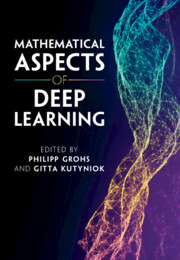Book contents
- Frontmatter
- Contents
- Contributors
- Preface
- 1 The Modern Mathematics of Deep Learning
- 2 Generalization in Deep Learning
- 3 Expressivity of Deep Neural Networks
- 4 Optimization Landscape of Neural Networks
- 5 Explaining the Decisions of Convolutional and Recurrent Neural Networks
- 6 Stochastic Feedforward Neural Networks: Universal Approximation
- 7 Deep Learning as Sparsity-Enforcing Algorithms
- 8 The Scattering Transform
- 9 Deep Generative Models and Inverse Problems
- 10 Dynamical Systems andOptimal Control Approach to Deep Learning
- 11 Bridging Many-Body Quantum Physics and Deep Learning via Tensor Networks
9 - Deep Generative Models and Inverse Problems
Published online by Cambridge University Press: 29 November 2022
- Frontmatter
- Contents
- Contributors
- Preface
- 1 The Modern Mathematics of Deep Learning
- 2 Generalization in Deep Learning
- 3 Expressivity of Deep Neural Networks
- 4 Optimization Landscape of Neural Networks
- 5 Explaining the Decisions of Convolutional and Recurrent Neural Networks
- 6 Stochastic Feedforward Neural Networks: Universal Approximation
- 7 Deep Learning as Sparsity-Enforcing Algorithms
- 8 The Scattering Transform
- 9 Deep Generative Models and Inverse Problems
- 10 Dynamical Systems andOptimal Control Approach to Deep Learning
- 11 Bridging Many-Body Quantum Physics and Deep Learning via Tensor Networks
Summary
Deep generative models have been recently proposed as modular datadriven priors to solve inverse problems. Linear inverse problems involve the reconstruction of an unknown signal (e.g. a tomographic image) from an underdetermined system of noisy linear measurements. Most results in the literature require that the reconstructed signal has some known structure, e.g. it is sparse in some known basis (usually Fourier or wavelet). Such prior assumptions can be replaced with pre-trained deep generative models (e.g. generative adversarial getworks (GANs) and variational autoencoders (VAEs)) with significant performance gains. This chapter surveys this rapidly evolving research area and includes empirical and theoretical results in compressed sensing for deep generative models.
- Type
- Chapter
- Information
- Mathematical Aspects of Deep Learning , pp. 400 - 421Publisher: Cambridge University PressPrint publication year: 2022
- 2
- Cited by

